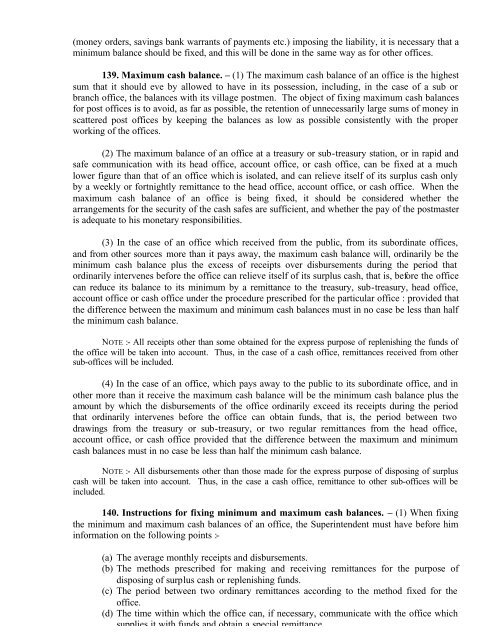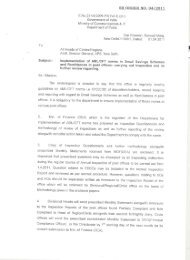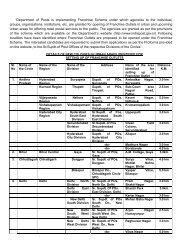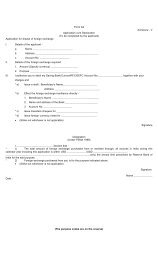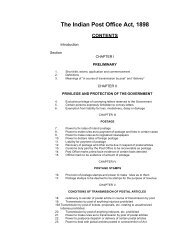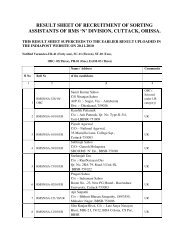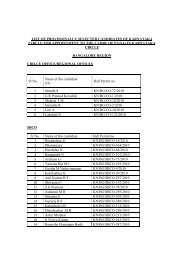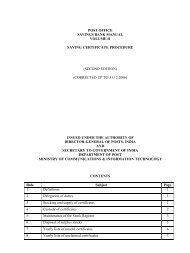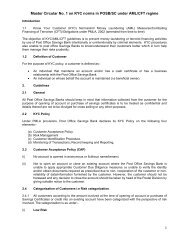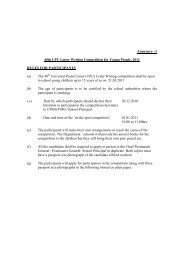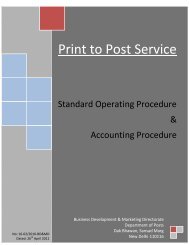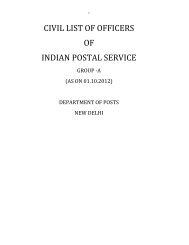Postal Manual Vol. VIII - India Post
Postal Manual Vol. VIII - India Post
Postal Manual Vol. VIII - India Post
You also want an ePaper? Increase the reach of your titles
YUMPU automatically turns print PDFs into web optimized ePapers that Google loves.
(money orders, savings bank warrants of payments etc.) imposing the liability, it is necessary that a<br />
minimum balance should be fixed, and this will be done in the same way as for other offices.<br />
139. Maximum cash balance. – (1) The maximum cash balance of an office is the highest<br />
sum that it should eve by allowed to have in its possession, including, in the case of a sub or<br />
branch office, the balances with its village postmen. The object of fixing maximum cash balances<br />
for post offices is to avoid, as far as possible, the retention of unnecessarily large sums of money in<br />
scattered post offices by keeping the balances as low as possible consistently with the proper<br />
working of the offices.<br />
(2) The maximum balance of an office at a treasury or sub-treasury station, or in rapid and<br />
safe communication with its head office, account office, or cash office, can be fixed at a much<br />
lower figure than that of an office which is isolated, and can relieve itself of its surplus cash only<br />
by a weekly or fortnightly remittance to the head office, account office, or cash office. When the<br />
maximum cash balance of an office is being fixed, it should be considered whether the<br />
arrangements for the security of the cash safes are sufficient, and whether the pay of the postmaster<br />
is adequate to his monetary responsibilities.<br />
(3) In the case of an office which received from the public, from its subordinate offices,<br />
and from other sources more than it pays away, the maximum cash balance will, ordinarily be the<br />
minimum cash balance plus the excess of receipts over disbursements during the period that<br />
ordinarily intervenes before the office can relieve itself of its surplus cash, that is, before the office<br />
can reduce its balance to its minimum by a remittance to the treasury, sub-treasury, head office,<br />
account office or cash office under the procedure prescribed for the particular office : provided that<br />
the difference between the maximum and minimum cash balances must in no case be less than half<br />
the minimum cash balance.<br />
NOTE :- All receipts other than some obtained for the express purpose of replenishing the funds of<br />
the office will be taken into account. Thus, in the case of a cash office, remittances received from other<br />
sub-offices will be included.<br />
(4) In the case of an office, which pays away to the public to its subordinate office, and in<br />
other more than it receive the maximum cash balance will be the minimum cash balance plus the<br />
amount by which the disbursements of the office ordinarily exceed its receipts during the period<br />
that ordinarily intervenes before the office can obtain funds, that is, the period between two<br />
drawings from the treasury or sub-treasury, or two regular remittances from the head office,<br />
account office, or cash office provided that the difference between the maximum and minimum<br />
cash balances must in no case be less than half the minimum cash balance.<br />
NOTE :- All disbursements other than those made for the express purpose of disposing of surplus<br />
cash will be taken into account. Thus, in the case a cash office, remittance to other sub-offices will be<br />
included.<br />
140. Instructions for fixing minimum and maximum cash balances. – (1) When fixing<br />
the minimum and maximum cash balances of an office, the Superintendent must have before him<br />
information on the following points :-<br />
(a) The average monthly receipts and disbursements.<br />
(b) The methods prescribed for making and receiving remittances for the purpose of<br />
disposing of surplus cash or replenishing funds.<br />
(c) The period between two ordinary remittances according to the method fixed for the<br />
office.<br />
(d) The time within which the office can, if necessary, communicate with the office which<br />
supplies it with funds and obtain a special remittance.


